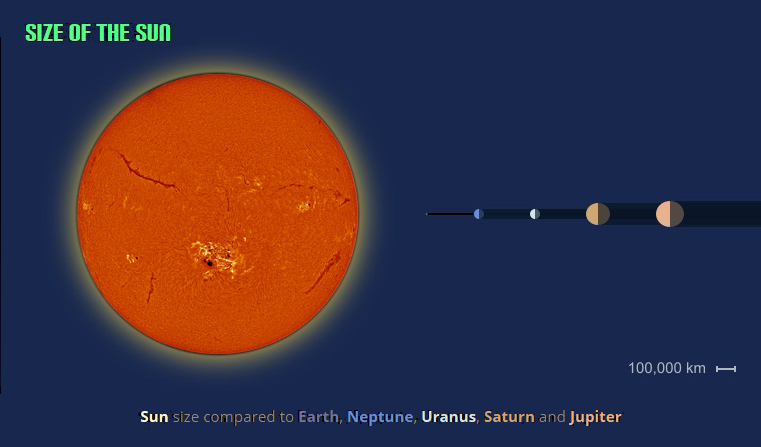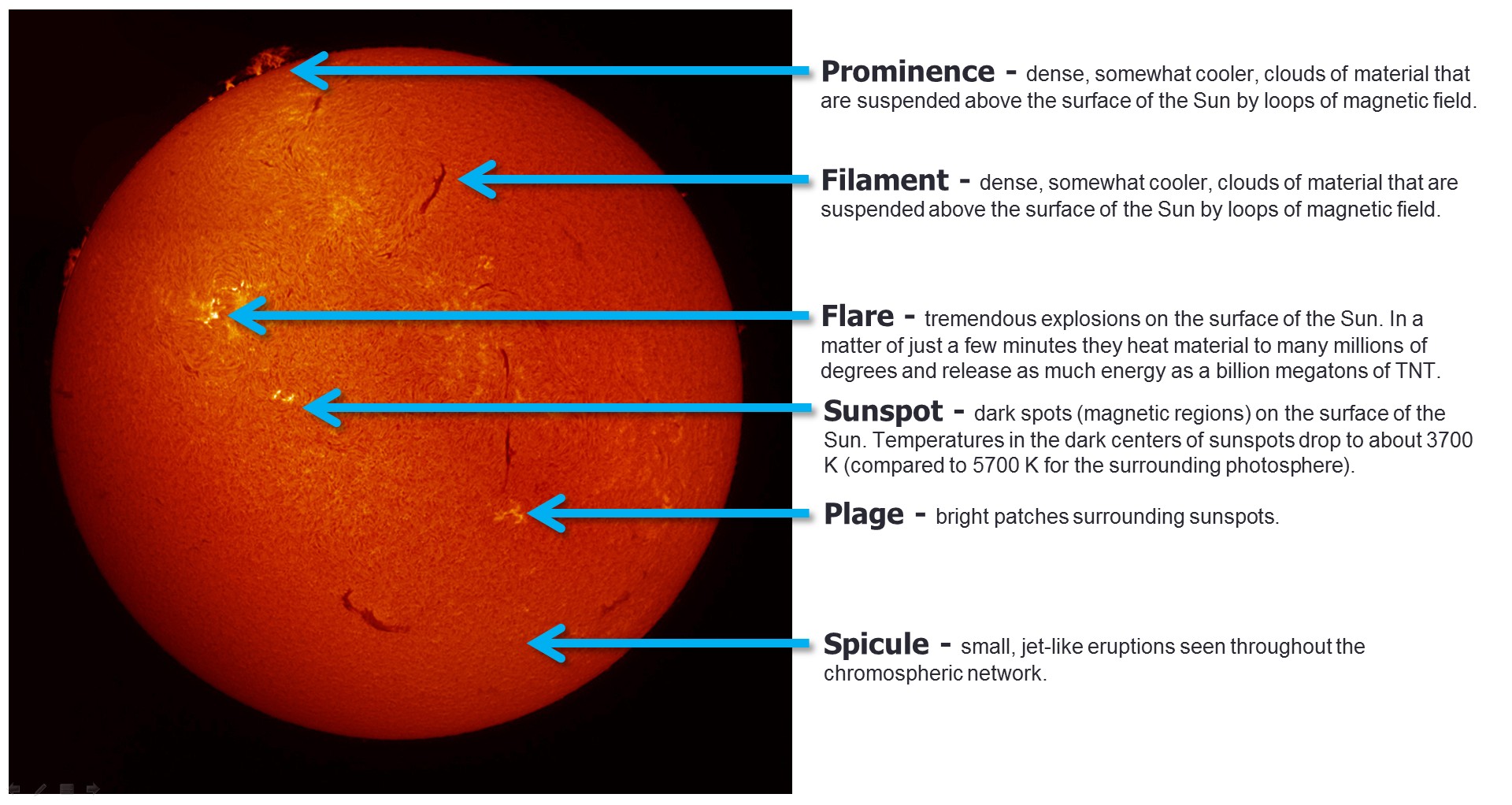|
The Sun (or Sol), is the star at the center of our solar system and is responsible for the Earth's climate and weather. The Sun is an almost perfect sphere with a difference of just 10 km (6.2 mi) in diameter between the poles and the equator. The average radius of the Sun is 695,508 km (432,168.6 mi) (109.2 x that of the Earth) of which 20-25% is the core.
|
|
Sun Profile
|
Age:
|
4.6 Billion Years
|
|
Type:
|
Yellow Dwarf (G2V)
|
|
Diameter:
|
1,392,684 km (865,373.7 mi)
|
|
Equatorial Circumference
|
4,370,005.6 km (2,715,395.6 mi)
|
|
Mass:
|
1.99 × 10^30 kg (333,060 Earths)
|
|
Satellites:
|
(See Satellites)
|
|
Surface Temperature:
|
5,500 °C (9,932 °F)
|
|

|
|
Sun Terms
|
Prominence:
|
Dense, somewhat cooler, clouds of material that are suspended above the surface of the Sun by loops of magnetic field.
|
|
Filament:
|
Dense, somewhat cooler, clouds of material that are suspended above the surface of the Sun by loops of magnetic field. Prominences and filaments are actually the same things except that prominences are seen projecting out above the limb of the Sun.
|
|
Flare:
|
Tremendous explosions on the surface of the Sun. In a matter of just a few minutes they heat material to many millions of degrees and release as much energy as a billion megatons of TNT.
|
|
Sunspot:
|
Dark spots (magnetic regions) on the surface of the Sun. Temperatures in the dark centers of sunspots drop to about 3700 K (compared to 5700 K for the surrounding photosphere).
|
|
Plage:
|
Bright patches surrounding sunspots.
|
|
Spicule:
|
Small, jet-like eruptions seen throughout the chromospheric network.
|
|

|
|
Sun Object Relative Sizes
|
Compare:
|
In the attached image, you can see how large a prominence and a filament can be with respect to the relative sizes of the Earth and Moon and the Earth-Moon separation distance.
|
|

|
|
Quick Sun Facts
- At its center, the Sun reaches temperatures of 15 million °C (27,000,032 °F).
- The Sun is all the colors mixed together, this appears white to our eyes.
- The Sun is mostly composed of hydrogen (70%) and Helium (28%).
- The Sun is a main-sequence G2V star (or Yellow Dwarf).
- The Sun is 4.6 billion years old.
- The Sun is 109 times wider than the Earth and over 333,000 times as massive.
|
|
Detailed Sun Facts
- One million Earths could fit inside the Sun.
If a hollow Sun was filled up with spherical Earths, then around 960,000 would fit inside. On the other hand, if these Earths were squished inside with no wasted space, then around 1,300,000 would fit inside. The Sun's surface area is 11,990 times that of the Earth's.
- The Sun contains 99.86% of the mass in the Solar System.
The mass of the Sun is approximately 330,000 times greater than that of Earth. It is almost three quarters Hydrogen, while most of the remaining mass is Helium.
- The Sun is an almost perfect sphere.
There is only a 10 kilometer (6.2 miles) difference in its polar diameter compared to its equatorial diameter. Considering the vast expanse of the Sun, this means it is the closest thing to a perfect sphere that has been observed in nature.
- The temperature inside the Sun can reach 15 million °C (27,000,032 °F).
At the Sun's core, energy is generated by nuclear fusion, as Hydrogen converts to Helium. Because hot objects generally expand, the Sun would explode like a giant bomb if it weren't for its enormous gravitational force. The temperature on the surface of the Sun is closer to 5,500 °C (9,932 °F).
- Eventually, the Sun will consume the Earth.
When all the Hydrogen has been burned, the Sun will continue for about 130 million more years, burning Helium, during which time it will expand to the point that it will engulf Mercury and Venus and the Earth. At this stage it will have become a red giant.
- The Sun will one day be about the size of Earth.
After its red giant phase, the Sun will collapse, retaining its enormous mass, but containing the approximate volume of our planet. When this happens, it will be called a white dwarf.
- Light from the Sun takes eight minutes to reach Earth.
With a mean average distance of 150 million kilometres (93,205,678.8 miles) from Earth and with light travelling at 300,000 kilometers (186411.4 miles) per second, dividing one by the other gives us an approximate time of 500 seconds, or eight minutes and 20 seconds. Although this energy reaches Earth in a few minutes, it will already have taken millions of years to travel from the Sun's core to its surface.
- The Sun travels at 220 kilometres (136.7 miles) per second.
The Sun is 24,000-26,000 light years from the galactic center and it takes the Sun 225-250 million years to complete an orbit of the center of the Milky Way.
- The distance from the Sun to Earth changes throughout the year.
Because the Earth travels on an elliptical orbit around the Sun, the distance between the two bodies varies from 147 to 152 million kilometers (91,341,565.3 to 94,448,421.2 miles). The distance between the Earth and the Sun is called an Astronomical Unit (AU).
- The Sun is middle-aged.
At around 4.5 billion years old, the Sun has already burned off about half of its store of Hydrogen. It has enough left to continue to burn Hydrogen for approximately another 5 billion years. The Sun is currently a type of star known as a Yellow Dwarf.
- The Sun has a very strong magnetic field.
Solar flares occur when magnetic energy is released by the Sun during magnetic storms, which we see as sunspots. In sunspots, the magnetic lines are twisted and they spin, much like a tornado would on Earth.
- The Sun generates solar wind.
This is a stream of charged particles, which travels through the Solar System at approximately 450 kilometres (279.6 miles) per second. Solar wind occurs where the magnetic field of the Sun extends into space instead of following its surface.
- Science Fiction Books - Sun
- Brin, David
- Uplift Universe
- Sundiver (1980)
- Startide Rising (1983)
- The Uplift War (1987)
- Brightness Reef (1995)
- Infinity's Shore (1996)
- Heaven's Reach (1998)
- Gorilla, My Dreams (2011)
- - Synopsis -
The novel (Sundiver) begins with the main character, Jacob Demwa, working at the center for uplift on Earth, while he recovers from a tragedy at the Vanilla Space Needle where he saved the space elevator from destruction but lost his love in the process. An alien friend of Demwa's, Fagin (a Kanten), contacts Demwa and offers him a job. Initially reluctant to return to his previous life as a scientific investigator, Demwa agrees to attend a secret meeting. He learns that there are "ghosts" appearing in the Sun's chromosphere. The ghosts are without precedent in the galactic library.
|
|
|
Satellites
|
Distance from the Sun
|
|
|
|
Name
|
kilometers
|
miles
|
AU
|
Orbital Period
|
Classification
|
|
Mercury
|
57,909,227 km
|
35,983,125.4 mi
|
0.39 AU
|
88 days
|
Planet
|
|
Venus
|
108,209,475 km
|
67,238,250.5 mi
|
0.73 AU
|
225 days
|
Planet
|
|
Earth
|
149,598,262 km
|
92,956,050.4 mi
|
1 AU
|
365.24 days
|
Planet
|
|
Mars
|
227,943,824 km
|
141,637,725.7 mi
|
1.38 AU
|
1.9 years
|
Planet
|
|
Ceres
|
413,700,000 km
|
257,061,262.2 mi
|
2.77 AU
|
4.6 years
|
Dwarf Planet
|
|
Jupiter
|
778,340,821 km
|
159,730,462.9 mi
|
5.20 AU
|
11.9 years
|
Planet
|
|
Saturn
|
1,426,666,422 km
|
886,489,415.6 mi
|
9.58 AU
|
29.5 years
|
Planet
|
|
Uranus
|
2,870,658,186 km
|
1,783,744,299.5 mi
|
19.22 AU
|
84.0 years
|
Planet
|
|
Neptune
|
4,498,396,441 km
|
2,795,173,959.7 mi
|
30.10 AU
|
164.8 years
|
Planet
|
|
Pluto
|
5,874,000,000 km
|
3,649,934,383.2 mi
|
39.26 AU
|
248.0 years
|
Dwarf Planet
|
|
Haumea
|
6,452,000,000 km
|
4,009,086,932.3 mi
|
43.13 AU
|
283.3 years
|
Dwarf Planet
|
|
Makemake
|
6,850,000,000 km
|
4,256,392,666.8 mi
|
45.79 AU
|
309.9 years
|
Dwarf Planet
|
|
Eris
|
10,120,000,000 km
|
6,288,276,465.4 mi
|
68.01 AU
|
560.9 years
|
Dwarf Planet
|
|
|
|
Solar System Data
|


